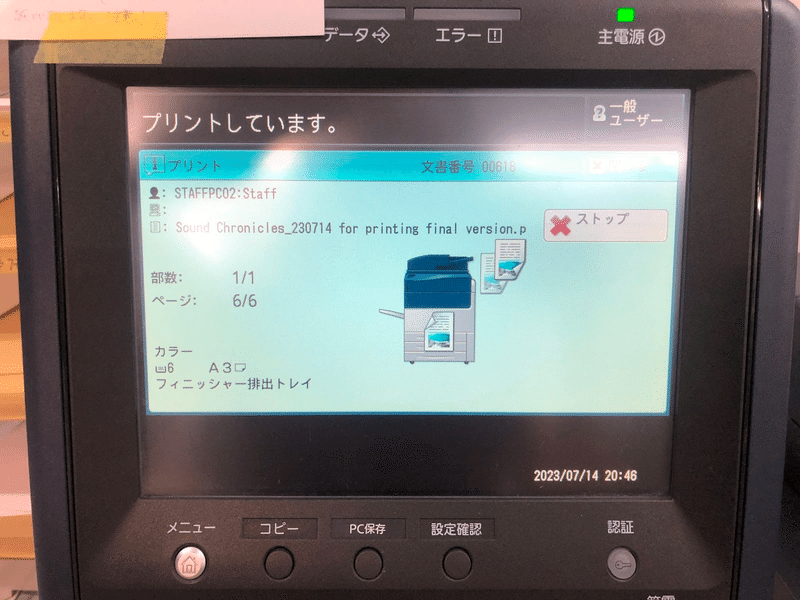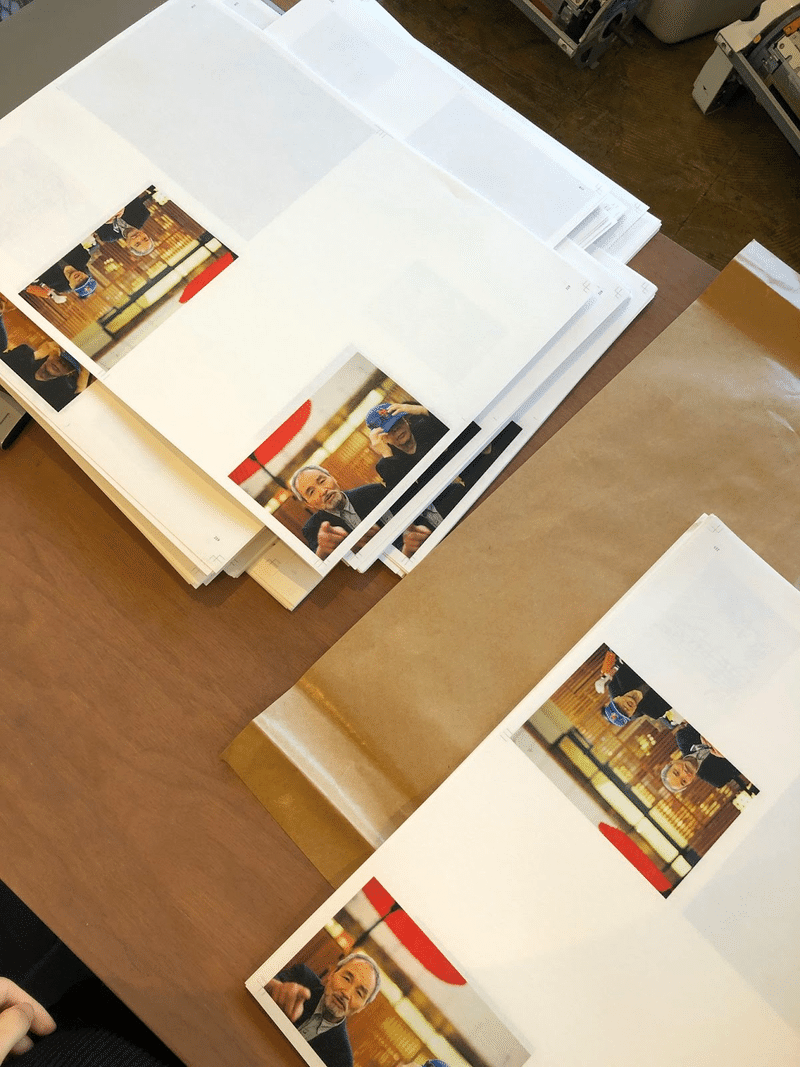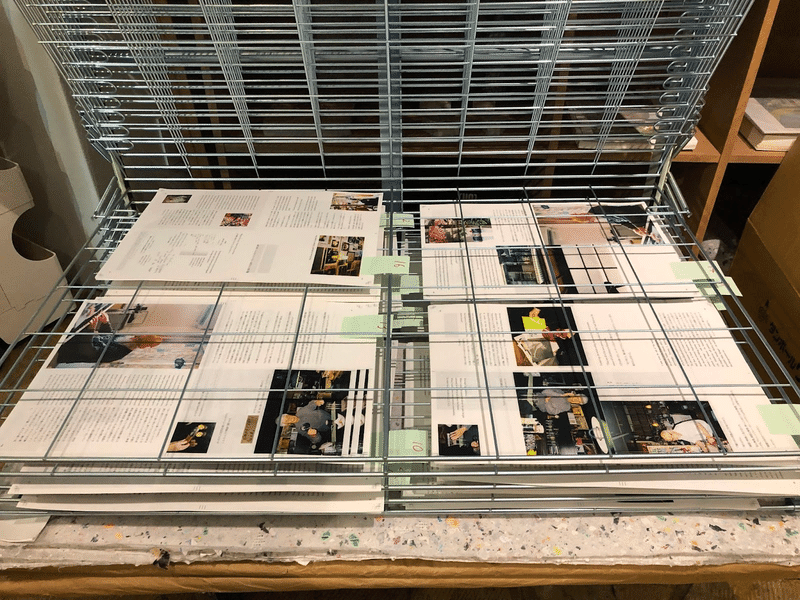PRINTING
Risograph printing is better suited for text and graphics rather than high resolution images. As more than one third of my book was filled with images, only the texts will be printed with risograph, and colour with laser.
In risograph printing, a master film is created for each page. The master film costs more than the ink, so the cost per copy decreases when more copies are printed. Whereas, ink is expensive for laser printing, so the cost increases per copy.
We struggled to find a printing shop because:
- Hardly any Internet or offline printing shops can allow you to bring your own specific paper.
- For Internet printing, the paper is folded when they deliver, and it’s not possible to print risograph when the papers are folded once.
I learned that for laser, the colour, speed, and ink vary greatly depending on the printer.
LASER PRINTING

I was excited to see this screen that years of exploration are going into print.
The first copy came out. The warm colours became grey, different from the test print at Neutral Colors.
“Yellow. This image is so yellow...”
Drowned in a yellow swamp, I was asked to check the colours of the first copy, although there was no time for adjustments. Risograph printing is in two days, it’s not just about my convenience, many people were involved. The print was distanced from the ideal colour, and yet I had to proceed.
After printing, I headed to Ginza Line station, hugging the stack of paper. A deep discouragement crept in. I zoned out from the bustling streets; the tears streamed down my face.
On the train, I recalled the washi craftsman Senda-san’s words that I should document my feelings now, so I began scribbling.
“The quality and colours were far away from what I Imagined. I poured everything into the layout and the book. In the end, the quality is different. One after another, it’s a compilation of my failures. The printer from Neutral Colors had beautiful colours. I’m so disappointed. For the cover, I still have a chance to do something about it. But, when it’s printed, it’s over. I don't even want to see, open, or show anyone. I’m not proud of it. I was so excited. Perhaps I should’ve stopped when the first copy came out. There’s no time. The photos are blurred.”
I returned home with puffy red eyes, hugging my paper and standing still like a tree bark at the door.
“What happened??” my photographer housemate asked me.
“...”
“Show me”, and he took the papers. “These are great! I'm telling you, this is quality print!”
“You're just trying to make me feel better.”
“No! I don't care about your feelings! I'm saying the truth, these are great prints.”
“... But, the colours are not right, and the images are so blurry. I think I didn’t convert the data properly.”
“This is normal! You cannot compare digital image with printed image!”
“Oh?”
The Next Morning (Saturday)
“This is too yellow” looped in my mind as I woke up, then I recalled Akiyoshi-san’s words during dinner commenting on an artwork, “This is not yellow.” By coincidence, her photograph became too yellow, which matches her iconic album “Long Yellow Road.”
I have no time for negativity. I still have to edit my Japanese and English writing and complete what I began.
My flatmate said, “Your foreword is not polished. I feel like five people are talking to me simultaneously. If it’s not perfect, it shouldn’t go to print tomorrow. Can’t you postpone it?”
“No, I have to print tomorrow!” He paused at every sentence with a baffled look.
Time became my biggest enemy. What should I prioritise? Foreword, layout, or writing. Aren’t they all important?
RISOGRAPH PRINTING
The night before printing, I intended to tweak the layout, but overwhelmed by emotions, I found myself adding more memories to the book.
While walking to Neutral Colors, I realised rather than adding more, I should have polished what I already had.
We took out the white paper during laser printing to reduce the printing cost, as an empty page that goes through the printer is also counted. We covered the printed page numbers with a white square on the risograph imposition PDF layout to avoid double printing. Then, physically put the white papers back in the correct order.

There were 56 PDF pages after the A3 imposition. Laser prints in the order of one copy from pages 1~56 (both sides), and nine copies took less than 30 minutes. Whereas, risograph prints the first page for nine copies, the second page, and so on.
That day, we printed the smooth side of the machine-made washi paper, 28 pages x 9 copies = 252 pages, which took five hours. The other side was printed the next day since the ink was not dried.
Risograph Printing Begins!
First, print two sheets of regular A3 paper, then place one sheet (text only) over the laser-printed washi paper (photo only) to check the orientation.
The consequence is fatal if the orientation of the paper is wrong. All nine copies can be ruined within a few seconds.
Then, look at the black line in the middle of the two sheets of paper to adjust the vertical and horizontal positions on the risograph printer in millimetres. Fine adjustments can be made in 0.1mm increments.
 I saw my layout mistakes during printing, and they don’t come off even if I rub them. Once printed, Command Z no longer works.
I saw my layout mistakes during printing, and they don’t come off even if I rub them. Once printed, Command Z no longer works.
We came out from Neutral Colors at 10:30 pm. Nakagawa-san said, “Usually, several people make a book together; it’s amazing how you came this far by yourself.” Even with her warm words, the pain lingered.
The other half was printed the next day.
THE DAY AFTER PRINTING
I headed to the washi shop, Paper Nao, for inspiration to fix my handmade washi cover. I visited the nearby jazz kissa Eigakan after a long time.
I came out from the toilet with dripping hands, he said to me. “There’s an air towel, but people don’t know about it”, so I returned to the toilet to use it.
“That’s self-made, more like a work of failure”, he said.
(Wow. That’s exactly how I feel right now. His words pierced through me.)
“How did you make it?”
“Two vacuum motors, one hair dryer, and a light sensor.”